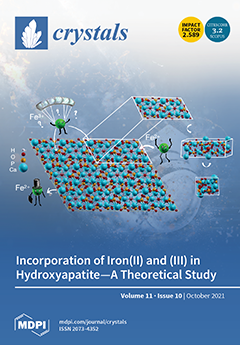Rare-earth-based Ca
9RE(PO
4)
7 (
RE = Nd, Gd, Dy) materials were synthesized by solid-state reaction at T = 1200 °C. The obtained tricalcium phosphate (TCP) materials are efficient light emitters due to the presence of
RE3+ ions,
[...] Read more.
Rare-earth-based Ca
9RE(PO
4)
7 (
RE = Nd, Gd, Dy) materials were synthesized by solid-state reaction at T = 1200 °C. The obtained tricalcium phosphate (TCP) materials are efficient light emitters due to the presence of
RE3+ ions, although these ions are present at high concentrations. Moreover, in these host structures, these ions can be used as optical probes to study their local environments. Thus, photoluminescence (PL) emission spectra of the powder samples clearly indicated, for Dy
3+ and Gd
3+ ions, the presence of the
RE3+ ion in low-symmetry sites with some local structural disorder, and the spectra show the presence of vibrational features (in the case of Gd
3+). For the Nd
3+ phase, emission bands are present around 900, 1050, and 1330 nm, originating from the
4F
3/2 level. In general, these
RE-TCP samples are interesting luminescent materials in the visible (Dy), UV (Gd), and NIR (Nd) regions, due to weak concentration quenching even for high concentrations of the emitting ion.
Full article





